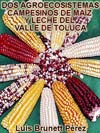Luis Brunett Pérez
Esta página muestra parte del texto pero sin formato.
Puede bajarse la tesis completa en PDF comprimido ZIP (198 páginas, 773 kb) pulsando aquí
RESUMEN
La presente investigación es un estudio de la sustentabilidad en dos niveles: El primer nivel consistió en un análisis comparativo de dos agroecosistemas campesinos de producción de maíz y leche durante dos ciclos de evaluación. El segundo, se dirigió a evaluar las fortalezas y debilidades de la propuesta metodológica “Marco para la Evaluación de Sistemas de Manejo de Recursos Naturales incorporando Indicadores de Sustentabilidad”. El estudio se realizó en el municipio de Almoloya de Juárez, México. Para efectos prácticos, se identificaron dos agroecosistemas: el convencional (AC), que presenta un esquema de producción de leche a través del cultivo de maíz y pastoreo en áreas comunes el cual es característico de la región; y el agroecosistema modificado (AM), donde la producción de leche se lleva a cabo a través de una serie de innovaciones tecnológicas que se vienen incorporando al agroecosistema convencional, desde 1992. Se trabajó con seis unidades de producción en cada agroecosistema. El periodo de evaluación fue de mayo de 1999 a abril de 2001. En el primer ciclo se diseñaron y evaluaron 12 indicadores, para el segundo, se trabajó con 26. Los indicadores se midieron con diferentes instrumentos. Los criterios que se seleccionaron para la comparación fueron: productividad, rentabilidad, eficiencia energética y de nitrógeno, calidad del suelo, dependencia de insumos externos, generación de empleos y calidad de vida. Los resultados para el primer ciclo de evaluación muestran que el AC presentó mejores valores en 5, peores en igual número y el mismo valor en 2. Para el segundo ciclo, los resultados fueron que el AC obtuvo mejores valores en 11, iguales en 5 y peores en 10. Aunque en el AM se obtienen mayores rendimientos por vaca con un menor costo de producción por litro de leche. En cuanto a la calidad del suelo, no se observaron diferencias significativas. Los datos permiten concluir que el AM es más sustentable que el AC, pero ambos se pueden mejorar aún más su perfil de sustentabilidad. Respecto a la metodología utilizada, requiere de ajustes para evaluar agroecosistemas mixtos de producción.
Palabras claves: Sustentabilidad, agroecosistemas y leche
ABSTRACT
The present investigation is a study of the sustainability in two levels: The first level consisted of a comparative analysis of two agroecosystems rural of production of corn and milk during two cycles of evaluation. The second, was directed to evaluate the fortresses and weaknesses of the proposed one metodologhy “Framework for the Natural Resources Management Systems Evaluation incorporating Indicators of Sustainability”. The study was carried out in the municipality of Almoloya of Juárez, Mexico. For practical effects, two were identified agroecosystems: the conventional one (AC), that presents a milk production plan through the cultivation of corn and grassing in common areas which is characteristic of the region; and the agroecosystem modified (AM), where the production of milk is carries out through a series of technological innovations that come itself incorporating al agroecosystem conventional, since 1992. Worked himself with six units of production in each agroecosystem. The period of evaluation was of May from 1999 to April of 2001. In the first cycle they were designed and they evaluated 12 indicators, for the second, worked itself with 26. The indicators were measured with different instruments. The criteria that were selected for the comparison they were: productivity, profit value, energy efficiency and of nitrogen, quality of the floor, dependence of external supplies, generation of jobs and quality of life. The results for the first cycle of evaluation show that the AC presented better values in 5, worse in equal number and the same value in 2. For the second cycle, the results were that the AC obtained better values in 11, equal in 5 and worse in 10. Although in the AM greater performances by cow with a smaller cost of production by liter of milk are obtained. As for the quality of the floor, themselves they were not observed you differentiate significant. The data permit to conclude that the AM is more sustainable than the AC, but both can improve still more their profile of sustainability. With respect to the methodology utilized, requires of adjustments to evaluate agroecosystems mixed of production.
Key words: agroecosystems, sustainability and milk


